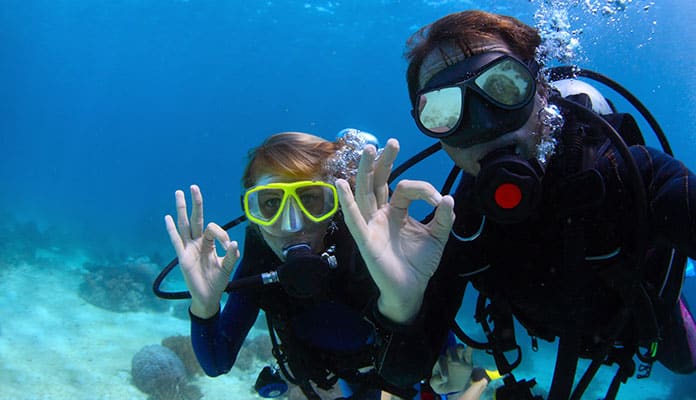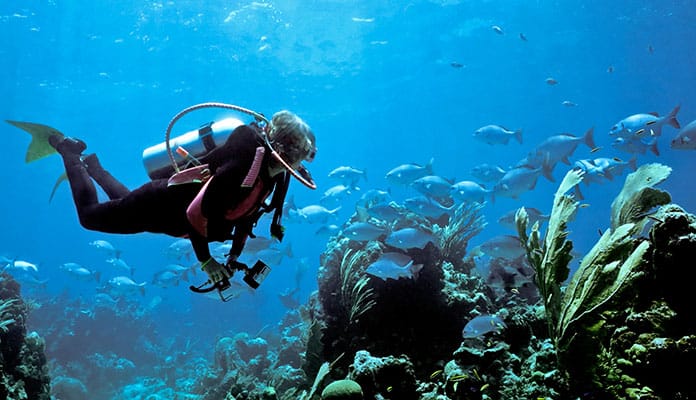
Here is everything you need to know about skin bends, the lesions which occur after diving, and how to handle them.
What Are Skin Bends?
Sometimes, after going for a dive, you may notice some rash-like lesions on your skin after coming back up. The deeper underwater you go, the more likely you are to experience these so-called skin bends. Some people are more prone to develop them, while others can be more resistant. Still, you will probably experience these rashes at some point in your diving life, even if you are among the luckier people who are not predisposed to them.
When you dive, the air you breathe through the tank is only designed to sustain you for a short-term incursion in the deep. During the dive, you breathe this air, which contains more oxygen and more nitrogen than you are usually inhaling in normal circumstances. While the oxygen is not a problem, the extra nitrogen does build up in your bloodstream and causes some unpleasant effects, starting with the immediately noticeable skin bends.
After you get out of the water and out of your scuba wetsuit, you may notice some red-looking areas of skin, most commonly on your arms and legs. The impression will be that of a rash, with various degrees of itching and burning associated with them. While most types of skin bends are harmless and you just need to wait for them to pass, others can have a more damaging effect or should be read as symptoms of potentially serious bodily harm.
Most Common Types of Skin Bends
 3 kinds of skin bends can develop after prolonged exposure to the unfriendly environment of the deep or the increased nitrogen levels derived from the oxygen tank. This is what you need to know about each type of skin bend, at a glance.
3 kinds of skin bends can develop after prolonged exposure to the unfriendly environment of the deep or the increased nitrogen levels derived from the oxygen tank. This is what you need to know about each type of skin bend, at a glance.
1. Mild rashes
- They look like your usual eczema, sunburn, or skin rash, and appear most commonly on the limbs and chest, or sometimes on the butt;
- They cause the expected itch and discomfort, but usually disappear on their own in a few hours since returning to the surface;
- For people with sensitive skin, however, these rashes can develop into more serious forms of skin lesions, if left untreated.
2. Moderate to severe rashes
- This type of irritations is considered level 2 of skin bends, and bears the scientific name of cutis marmorata (roughly translatable to ‘marbled skin’ because of the veiny or mottled appearance of the rash);
- These rashes can appear in the same areas as the mild rashes, but they heal much slower and can even extend into new areas overtime’
- Furthermore, if you scratch or rub the affected areas of the skin, this may cause permanent damage resulting in scars or wounds.
3. Lymphatic DCS
- Finally, the most severe form of skin corresponds to a DCS-related inflammation of the lymph nodes, a dangerous state which can compromise your entire immune system;
- The DCS in the name of this third type of skin bend stands for decompression sickness, a related condition we will describe just below;
- Unlike the other forms of skin bends which are limited to rashes, in the case of lymphatic DCS you can see a visible swelling of certain skin areas. This signals that the skin bend is very dangerous to your health and that you should see a doctor immediately.
What Is Decompression Sickness?
Decompression sickness, or DCS, is the umbrella name for all the negative physical changes which might be experienced by a scuba diver after a dive. The skin lesions that are visible immediately (aka skin bends) are only part of the decompression sickness, which can include other symptoms as well.
So, if you were wondering whether skin bends and decompression sickness are the same things, the answer is no. Most of the time, the mild forms of decompression sickness can mean skin bends for the person suffering from it, but it can also include other manifestations.
Possible symptoms of decompression sickness, besides skin bends, can include intense fatigue, vertigo (dizziness), pain in the joints, migraines or the feeling that you can’t think clearly, a funny feeling in the arms and legs (numbness, tingling, weakness and so on).
In any case, if you experience serious symptoms after a dive (extreme numbness, dizziness, or severe rashes), you should go for a check-up as soon as you can. In rare cases, and especially if you have a hidden heart defect, decompression sickness can lead to an embolism and other serious health threats. Having a doctor take a look and even performing a PFO scan (checking for a Patent Foramen Ovale, which means a little hole in the opening of the heart valve) is the safest course of action.
How to Treat Skin Bends
People that are usually experiencing skin rashes tend to dismiss them as not very important, if mildly annoying. Waiting for them to pass by default is a reasonable course of action when dealing with regular skin rashes, not related to deep water diving. However, when you know you are a diver and that the rash you are experiencing is probably a skin bend, you should make it much more seriously.
The dangers of ignoring skin bends, even the more superficial ones, are many. Since the chief cause of skin bends is the increased level of nitrogen in your blood, experiencing this condition repeatedly can lead to permanent damage to your breathing system. The more serious cases can even develop into a neurological type of DCS, which is obviously even riskier to your health.
Therefore, the best thing to do whenever you experience skin bends is to have a doctor assess the situation as soon as possible. Even if you’re dealing with just a mild rash, if it doesn’t disappear in a few hours you need to see a doctor right away. The treatment for skin bends usually takes a while, and you need to stick to it. It’s the only way to make sure the skin bends don’t affect your health or put you at risk for serious bodily harm.
It is also very important to stop all diving activity if you experience skin bends, even if they are very mild and disappear by themselves in a few hours. If all continues to be well, you can go back to scuba diving, but only after waiting a few more days. If they don’t disappear fast, then you need to see a physician right away.
You might also like: Can You Scuba Dive With Glasses Or Contact Lenses?
How to Prevent Skin Bends
 It’s difficult to prevent skin bends since they are caused by the pressures faced by the body when immersed in an unnatural environment. The only possible way to diminish the risk of developing skin bends is to stay properly hydrated. Drink enough water before diving, and maintain a regime of drinking at least 8 glasses of water per day even on dive-free days.
It’s difficult to prevent skin bends since they are caused by the pressures faced by the body when immersed in an unnatural environment. The only possible way to diminish the risk of developing skin bends is to stay properly hydrated. Drink enough water before diving, and maintain a regime of drinking at least 8 glasses of water per day even on dive-free days.
You should also know that the risk of getting skin bends gets higher the more you expose yourself to the unforgiving depths of the water. So another good way of preventing skin bends is to avoid going in too deep, especially if you’re not used to it or if you just dived. If you still plan on visiting the depths, do it gradually, and only guided by a more experienced diver.
Your physical condition can also increase the risk of getting skin bends. Women are more likely than men to develop them, as well as people who smoke, consume alcohol, or have a higher percentage of bodily fat. But beyond these statistical tendencies, there is the reality that proper precautions will keep you safe and diving responsibly is more important than any theoretical risk factor.
Globo Surf Overview
As long as you go diving fully prepared, with proper guidance, and do it slowly, you will be protected from truly risky instances of skin bends. As soon as you notice any marks on your skin, keep an eye on the situation and go to a doctor straight away if the rashes don’t go away in a few hours or if there’s any swelling.
There is also a good chance that you will never experience skin bends at all since there are plenty of divers who don’t. It’s important to know the risks and how to recognize them, but rest assured that many scuba divers never develop any rashes. Time will tell, and the more you dive, the more resistant you will become. Take it slowly and enjoy your dives!
More Scuba Reviews:
- Dive Watches Under 500
- Ladies Dive Watch
- Underwater Scooter
- Scuba Regulator
- Rebreather
- Cressi Giotto
- Aqualung I300
- Citizen Bm8180-03e

